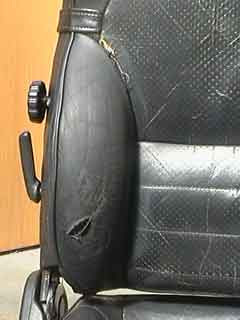1. Understanding Car AC Systems
Most people don’t realize how complex car air conditioning systems are. To effectively address AC issues, it’s helpful to know how these systems work. At its core, a car’s AC system transforms a refrigerant from a liquid to a gas, which absorbs heat and humidity, leav...
1. Understanding Car AC Systems
Most people don’t realize how complex car air conditioning systems are. To effectively address AC issues, it’s helpful to know how these systems work. At its core, a car’s AC system transforms a refrigerant from a liquid to a gas, which absorbs heat and humidity, leaving you with cool, dry air.
This process involves several key components, each playing a crucial role:
-
Compressor: The compressor, mounted at the front of the engine, pressurizes the refrigerant gas. It’s a critical component, and if it fails, it often requires a costly replacement.
-
Condenser: Located behind the vehicle’s grille, the condenser cools the refrigerant and releases heat. Fans within the condenser help dissipate this heat.
-
Dryer: The dryer removes water from the refrigerant, preventing moisture-related issues.
-
Metering Device/Expansion Valve: This component reduces the temperature and pressure of the refrigerant.
-
Evaporator: Mounted behind the dashboard, the evaporator is where the cooling occurs. The refrigerant changes back to a liquid state, cooling the air that passes over it.
-
Hoses/Lines: Refrigerant flows through these hoses, connecting the various components of the AC system.
2. Common Car AC Problems and Their Costs
Before diving into repairs, identifying the specific problem is essential. Here are four common AC issues, potential causes, and repair options.
2.1. Lack of Cold Air
One of the most frustrating problems is an AC system that blows cool but not cold air. Several factors can cause this:
- Low Refrigerant: Over time, AC systems lose refrigerant and need recharging.
- Blocked or Broken Fans: If the condenser fans aren’t functioning, airflow is affected.
- Dirty Cabin Air Filter: A clogged filter restricts airflow and cooling efficiency.
- Leaks: Leaks reduce the pressure and effectiveness of the AC system.
- Electrical Problems: Electrical issues can interfere with the AC system’s cooling process.
- Failing Compressor or Compressor Clutch: A malfunctioning compressor won’t produce cool air.
Repair Options:
- DIY Troubleshooting:
- Clear debris from the condenser and radiator.
- Check if the fans are turning.
- Replace the cabin air filter.
- Recharge the system with an at-home AC recharge kit (starting at $35).
- Professional Diagnosis: If DIY steps don’t resolve the issue, a mechanic can provide a comprehensive diagnosis.
2.2. Refrigerant Leaks
Leaks are a common cause of AC problems. Because the AC system is closed and pressurized, any leak can disrupt the flow of cold air. Untreated leaks can cause the compressor to overwork and eventually fail.
Repair Options:
- Visual Inspection: Check fittings, seals, and hoses to ensure they are securely attached.
- DIY Leak Detection Kit: Use an at-home AC leak detection kit (around $145) to pinpoint leaks.
- Professional Repair: A mechanic can diagnose and repair leaks, typically costing around $200 for diagnosis and an additional $350 for hose repair or replacement.
2.3. Compressor Clutch Issues
A loud noise when you turn on the AC can indicate a failing compressor clutch. Other signs include:
- Air that’s not cold enough.
- Inability to turn the AC on or off.
- Leaking refrigerant.
- The clutch not turning when the AC is activated.
Repair Options:
- Clutch Replacement: Replacing the clutch alone costs approximately $450 to $850, plus $150 to $250 for professional installation.
- Compressor Replacement: If the clutch is failing, the entire compressor may need replacement, which is a more expensive option.
2.4. Musty Odors
A moldy or musty smell indicates bacteria or mold growth, often caused by:
- A malfunctioning dryer.
- Mold on the evaporator.
- Dirty or moldy vents.
Repair Options:
- Vent Cleaning: Use an AC vent and duct cleaner (around $10) to clean the vents.
- Dryer Replacement: If the smell persists, replacing the dryer may be necessary, costing approximately $320 to $400, including parts and labor.
3. Average Car AC Repair Costs
AC repair costs vary based on the problem’s complexity and the vehicle type. On average, car AC repairs range from $430 to $520. However, a new compressor can cost between $1,300 and $2,500 or more.
3.1. Cost Breakdown of Common AC Repairs
| Repair |
Average Cost |
| AC system inspection and diagnostics |
$200 |
| AC recharge (at mechanic shop) |
$235 |
| AC hose repair |
$350 |
| Compressor clutch replacement |
$850 |
| New compressor |
$800+ |
| New car AC installation or total system replacement |
$2,750+ |
3.2. Factors Influencing AC Repair Costs
Several factors can affect the overall cost of AC repairs:
- Cause of the Problem: Some AC components are more expensive to repair or replace.
- Type of Car: High-end vehicles typically have higher repair costs.
- Diagnostics: Complex issues require more diagnostic time, increasing labor costs.
- DIY vs. Professional Repair: DIY repairs can save on labor costs if you have the skills and tools.
4. Maximizing Your Car AC Repair Budget
To keep your car AC repair costs manageable, consider the following tips:
- Regular Maintenance: Regular AC system checks can prevent minor issues from escalating into major repairs.
- DIY Solutions: Simple tasks like replacing the cabin air filter or recharging the AC can be done at home.
- Compare Quotes: Get quotes from multiple mechanics to ensure you’re getting a fair price.
- Warranty Coverage: Check if your vehicle’s warranty covers AC repairs.
At CARDIAGTECH.NET, we offer a range of high-quality tools to help you tackle car AC repairs efficiently and effectively. Here are some essential tools you should consider:
5.1. AC Manifold Gauge Set
An AC manifold gauge set is crucial for diagnosing AC system issues. It allows you to measure the pressure in the high and low sides of the AC system, helping you identify problems like low refrigerant, compressor issues, or blockages.
Benefits:
- Accurate pressure readings
- Easy to use and interpret data
- Durable construction for long-term use
5.2. Vacuum Pump
A vacuum pump is used to remove air and moisture from the AC system before recharging it. This ensures that the system operates efficiently and prevents damage from contaminants.
Benefits:
- Efficiently removes air and moisture
- Essential for proper AC system function
- Helps extend the life of AC components
5.3. Refrigerant Leak Detector
A refrigerant leak detector helps you pinpoint the exact location of leaks in the AC system. This tool uses electronic sensors to detect refrigerant escaping from hoses, fittings, or components.
Benefits:
- Accurately identifies refrigerant leaks
- Saves time and effort in troubleshooting
- Helps prevent further damage to the AC system
5.4. UV Dye Leak Detection Kit
UV dye leak detection kits involve injecting a special dye into the AC system and using a UV light to locate leaks. The dye glows under UV light, making it easy to spot even small leaks.
Benefits:
- Easy to use and highly effective
- Works on all types of refrigerants
- Provides a visual indication of leaks
5.5. AC System Flush Kit
An AC system flush kit is used to clean out contaminants and debris from the AC system. This kit helps remove oil, sludge, and other particles that can clog the system and reduce its efficiency.
Benefits:
- Improves AC system performance
- Extends the life of AC components
- Helps prevent costly repairs
5.6. Digital Thermometer
A digital thermometer is useful for measuring the temperature of the air coming out of the AC vents. This helps you determine if the AC system is cooling properly and identify potential issues.
Benefits:
- Accurate temperature readings
- Easy to use and interpret data
- Helps diagnose cooling problems
A compressor clutch removal tool is designed to safely and easily remove the compressor clutch without damaging the compressor or other components.
Benefits:
- Makes compressor clutch replacement easier
- Prevents damage to AC components
- Saves time and effort in repairs
6. Step-by-Step Guide to Diagnosing and Repairing Car AC Problems
With the right tools and knowledge, you can diagnose and repair many common car AC problems yourself. Here’s a step-by-step guide to help you get started:
Before you begin, make sure you have all the necessary tools and supplies, including:
- AC manifold gauge set
- Vacuum pump
- Refrigerant leak detector
- UV dye leak detection kit
- AC system flush kit
- Digital thermometer
- Compressor clutch removal tool (if needed)
- Refrigerant
- Safety glasses and gloves
Start by visually inspecting the AC system for any obvious signs of damage or leaks. Check the hoses, fittings, and components for cracks, corrosion, or leaks.
6.3. Use the AC Manifold Gauge Set
Connect the AC manifold gauge set to the service ports on the AC system. Measure the pressure in the high and low sides of the system and compare the readings to the manufacturer’s specifications.
6.4. Check for Refrigerant Leaks
Use a refrigerant leak detector or UV dye leak detection kit to check for leaks in the AC system. Pay close attention to the hoses, fittings, and components.
6.5. Flush the AC System
If you suspect that the AC system is contaminated with oil, sludge, or other debris, use an AC system flush kit to clean it out.
6.6. Replace Damaged Components
If you find any damaged components, such as hoses, fittings, or the compressor clutch, replace them with new ones.
6.7. Recharge the AC System
After repairing any leaks or replacing damaged components, recharge the AC system with the correct type and amount of refrigerant.
6.8. Test the AC System
After recharging the AC system, use a digital thermometer to measure the temperature of the air coming out of the AC vents. The air should be cold and the AC system should be functioning properly.
7. Why Choose CARDIAGTECH.NET for Your Car AC Repair Needs?
Choosing the right supplier for your car AC repair tools is crucial for ensuring the quality and reliability of your repairs. Here’s why CARDIAGTECH.NET is the best choice:
- High-Quality Tools: We offer a wide range of high-quality tools that are designed to meet the needs of professional mechanics and DIY enthusiasts alike.
- Competitive Prices: We offer competitive prices on all of our tools, so you can get the best value for your money.
- Expert Advice: Our team of experts is always available to answer your questions and provide advice on which tools are best for your specific needs.
- Excellent Customer Service: We are committed to providing excellent customer service and ensuring that you are completely satisfied with your purchase.
8. The Importance of Regular Car AC Maintenance
Regular maintenance is key to keeping your car’s AC system in top condition and avoiding costly repairs. Here are some maintenance tips to follow:
- Check the Refrigerant Level: Check the refrigerant level regularly and recharge the system if it’s low.
- Replace the Cabin Air Filter: Replace the cabin air filter every 12,000 to 15,000 miles to ensure proper airflow and cooling efficiency.
- Clean the Condenser: Clean the condenser regularly to remove debris and ensure proper airflow.
- Inspect the Hoses and Fittings: Inspect the hoses and fittings regularly for cracks, corrosion, or leaks.
- Run the AC Regularly: Run the AC regularly, even in the winter, to keep the system lubricated and prevent the seals from drying out.
9. Addressing Customer Challenges with CARDIAGTECH.NET
We understand the challenges faced by automotive technicians and garage owners, including the physical demands of the job, constant exposure to chemicals, and the need to stay updated with the latest technology. That’s why CARDIAGTECH.NET is dedicated to providing tools and equipment that enhance efficiency, accuracy, and safety.
9.1. Enhancing Efficiency and Reducing Repair Time
Our tools are designed to help you work faster and more efficiently, reducing the time it takes to complete repairs. This not only increases your productivity but also allows you to serve more customers.
9.2. Improving Accuracy and Safety
Our high-quality tools ensure that you can perform repairs with greater accuracy and safety, minimizing the risk of errors and accidents.
9.3. Saving Costs for Customers
By using our tools, you can accurately diagnose and repair AC problems, preventing unnecessary part replacements and saving costs for your customers.
9.4. Increasing Revenue and Profitability
Our tools help you provide high-quality services that increase customer satisfaction and drive repeat business, ultimately boosting your revenue and profitability.
9.5. Enhancing Your Garage’s Reputation
By using our reliable and efficient tools, you can enhance your garage’s reputation for quality and customer service, attracting more customers and building long-term relationships.
10. Call to Action: Get Expert Assistance from CARDIAGTECH.NET
Are you ready to take your car AC repair capabilities to the next level? Contact CARDIAGTECH.NET today for expert advice and assistance in selecting the right tools for your needs. Our team is here to help you enhance your efficiency, accuracy, and profitability.
Contact Information:
- Address: 276 Reock St, City of Orange, NJ 07050, United States
- WhatsApp: +1 (641) 206-8880
- Website: CARDIAGTECH.NET
Don’t let AC problems keep you or your customers uncomfortable. Invest in the best tools from CARDIAGTECH.NET and ensure that every repair is done right. Contact us now to learn more and place your order.





